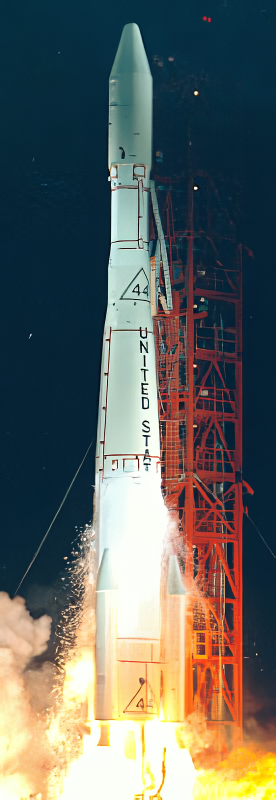
Thor Delta E1
In-activeMcDonnell Douglas (MDC)
July 1, 1966
Description
American orbital launch vehicle family with Thor first stage and a delta second stage.
Specifications
-
Stages
4 -
Length
28.0 m -
Diameter
2.44 m -
Fairing Diameter
2.44 m -
Launch Mass
68.0 T -
Thrust
1450.0 kN
Family
-
Name
Thor Delta E1 -
Family
― -
Variant
Delta E1 -
Alias
― -
Full Name
Thor Delta E1
Payload Capacity
-
Launch Cost
― -
Low Earth Orbit
540.0 kg -
Geostationary Transfer
Orbit
150.0 kg -
Direct Geostationary
― -
Sun-Synchronous Capacity
―
McDonnell Douglas
Commercial
None
MDCNone
Thor Delta E1 | Isis 2
McDonnell Douglas | United States of AmericaVandenberg SFB, CA, USA
April 1, 1971, 2:57 a.m.
Status: Launch Successful
Mission:
ISIS 2 was an ionospheric observatory instrumented with a sweep- and a fixed-frequency ionosonde, a VLF receiver, energetic and soft particle detectors, an ion mass spectrometer, an electrostatic probe, a retarding potential analyzer, a beacon transmitter, a cosmic noise experiment, and two photometers.
Low Earth OrbitThor Delta E1 | IMP G
McDonnell Douglas | United States of AmericaVandenberg SFB, CA, USA
June 21, 1969, 8:47 a.m.
Thor Delta E1 | ESSA 9
McDonnell Douglas | United States of AmericaCape Canaveral SFS, FL, USA
Feb. 26, 1969, 7:47 a.m.
Thor Delta E1 | Isis 1
McDonnell Douglas | United States of AmericaVandenberg SFB, CA, USA
Jan. 30, 1969, 6:46 a.m.
Status: Launch Successful
Mission:
ISIS 1 (International Satellite for Ionosphere Studies) was an ionospheric observatory instrumented with sweep- and fixed-frequency ionosondes, a VLF receiver, energetic and soft particle detectors, an ion mass spectrometer, an electrostatic probe, an electrostatic analyzer, a beacon transmitter, and a cosmic noise experiment.
Elliptical OrbitThor Delta E1 | HEOS 1
McDonnell Douglas | United States of AmericaCape Canaveral SFS, FL, USA
Dec. 5, 1968, 6:55 p.m.
Status: Launch Successful
Mission:
HEOS 1 (Highly Eccentric Orbit Satellite) was an earth-orbiting, spin-stabilized satellite that was launched by ESA. The spacecraft objectives were to study interplanetary magnetic fields, cosmic rays, the solar wind, and the magnetosheath.
Elliptical OrbitThor Delta E1 | Pioneer 9
McDonnell Douglas | United States of AmericaCape Canaveral SFS, FL, USA
Nov. 8, 1968, 9:46 a.m.
Status: Launch Successful
Mission:
Pioneer A to E (Pioneer 6 to 9 after launch) were a series of five solar-orbiting, spin-stabilized, solar-cell and battery-powered satellites designed to obtain measurements of interplanetary phenomena from widely separated points in space on a continuing basis.
Heliocentric N/AThor Delta E1 | GEOS B
McDonnell Douglas | United States of AmericaVandenberg SFB, CA, USA
Jan. 11, 1968, 4:16 p.m.
Thor Delta E1 | Pioneer 8
McDonnell Douglas | United States of AmericaCape Canaveral SFS, FL, USA
Dec. 13, 1967, 2:08 p.m.
Status: Launch Successful
Mission:
Pioneer A to E (Pioneer 6 to 9 after launch) were a series of five solar-orbiting, spin-stabilized, solar-cell and battery-powered satellites designed to obtain measurements of interplanetary phenomena from widely separated points in space on a continuing basis.
Heliocentric N/AThor Delta E1 | ESSA 6
McDonnell Douglas | United States of AmericaVandenberg SFB, CA, USA
Nov. 10, 1967, 5:53 p.m.
Thor Delta E1 | INTELSAT II F-4
McDonnell Douglas | United States of AmericaCape Canaveral SFS, FL, USA
Sept. 28, 1967, 12:45 a.m.
Thor Delta E1 | Explorer 35
McDonnell Douglas | United States of AmericaCape Canaveral SFS, FL, USA
July 19, 1967, 2:19 p.m.
Thor Delta E1 | IMP F
McDonnell Douglas | United States of AmericaVandenberg SFB, CA, USA
May 24, 1967, 2:05 p.m.
Thor Delta E1 | INTELSAT II F-3
McDonnell Douglas | United States of AmericaCape Canaveral SFS, FL, USA
March 23, 1967, 1:30 a.m.
Thor Delta E1 | INTELSAT II F-2
McDonnell Douglas | United States of AmericaCape Canaveral SFS, FL, USA
Jan. 11, 1967, 10:55 a.m.
Thor Delta E1 | INTELSAT II F-1
McDonnell Douglas | United States of AmericaCape Canaveral SFS, FL, USA
Oct. 26, 1966, 11:05 p.m.
Thor Delta E1 | Pioneer 7
McDonnell Douglas | United States of AmericaCape Canaveral SFS, FL, USA
Aug. 17, 1966, 3:20 p.m.
Status: Launch Successful
Mission:
Pioneer A to E (Pioneer 6 to 9 after launch) were a series of five solar-orbiting, spin-stabilized, solar-cell and battery-powered satellites designed to obtain measurements of interplanetary phenomena from widely separated points in space on a continuing basis.
Heliocentric N/AThor Delta E1 | Explorer 33
McDonnell Douglas | United States of AmericaCape Canaveral SFS, FL, USA
July 1, 1966, 4:02 p.m.
Falcon 9
Starlink Group 15-12
Space Launch Complex 4E - Vandenberg SFB, CA, USAA batch of 27 satellites for the Starlink mega-constellation - SpaceX's project for space-based Internet communication system.
Electron
Raise and Shine (RAISE-4)
Rocket Lab Launch Complex 1B - Rocket Lab Launch Complex 1, Mahia Peninsula, New ZealandRAISE-4 (RApid Innovative payload demonstration Satellite-4) is a Japan Aerospace Exploration Agency (JAXA) satellite for on-orbit demonstrations of …
Kuaizhou 11
DEAR-5
Launch Area 95A - Jiuquan Satellite Launch Center, People's Republic of ChinaDEAR-5 is a commercial in-orbit payload and micro-gravity experiments hosting spacecraft developed by Chinese commercial company AZSPACE for various …
Long March 12
SatNet LEO Group 16
Commercial LC-2 - Wenchang Space Launch Site, People's Republic of ChinaA batch of Low Earth Orbit communication satellites for the Chinese state owned SatNet constellation operated by the China Satellite Network Group. …
Falcon 9
Starlink Group 6-90
Space Launch Complex 40 - Cape Canaveral SFS, FL, USAA batch of 29 satellites for the Starlink mega-constellation - SpaceX's project for space-based Internet communication system.

